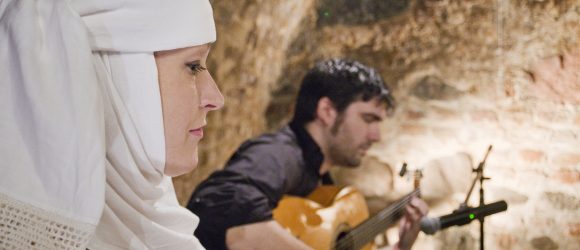Defense of the artistic research project “Transformations of the Vocal Timbre: The Influence of Ethnic Traditions’ Practice on the Contemporary Performer”
- 2018-11-21
- | News

On December 5–6, 2018, the defense of Brigita Bublytė’s artistic doctorate project “Transformations of the Vocal Timbre: The Influence of Ethnic Traditions’ Practice on the Contemporary Performer” will take place at the Lithuanian Academy of Music and Theatre. Artistic supervisor of the project – Prof. Nelė Klimienė-Savičenko, research supervisor – Assoc Prof. Dr. Ramunė Balevičiūtė, research consultant – Prof. Habil. Dr. Daiva Vyčinienė. Copies of the research paper and its summary are available at the library of the Lithuanian Academy of Music and Theatre (Gedimino pr. 42).
Free entrance.
Defense of the creative part of the artistic doctorate project
December 5, 2018, 6 p.m.
BALCONY THEATRE (Gedimino pr. 42, Vilnius)
PROGRAM
Documentary film Sutarmenko (2016, dir. Armas Rudaitis) – 50′
Screening of the performance Circle of Rasas (2016) – 13′ (short version)
Exhibition of Brigita Bublytė’s research-based schemes Visualisations of Voice Expression
Defense of the artistic research paper
December 6, 2018, 10 a.m.
JUOZAS KAROSAS HALL (Gedimino pr. 42, Vilnius)
CHAIR OF THE DEFENSE BOARD OF ARTISTIC RESEARCH PROJECT – Prof. Vytautas Anužis (Lithuanian Academy of Music and Theatre, Theatre, Acting);
BOARD MEMBERS: Prof. Aidas Giniotis (LMTA, Theatre, Directing), Prof. Asta Krikščiūnaitė (LMTA, Music, Singing), Prof. Dr. Aušra Martišiūtė-Linartienė (LMTA, Humanities, Philogogy), Prof. Dr. Valdis Muktupavels (Latvian University, Humanities, Art Research);
REVIEWERS: Assoc. Prof. Dr. Ramūnas Motiekaitis (LMTA, Music, Composition), Prof. Dr. Rasa Vasinauskaitė (LMTA, Humanities, Theatre Studies).
Abstract
Transformations of the Vocal Timbre: The Influence of Ethnic Traditions’ Practice on the Contemporary Performer is an interdisciplinary artistic research paper primarily orientated towards a professional contemporary stage performer – actor, singer or performance artist. However, due to the interconnectedness and communication between different areas in the world of contemporary arts as well as the vocal expression entering the spheres of contemporary dance, visual art and poetry, this research will also be of interest to the professionals and non-professionals of other artistic fields. The main subject of the research is the contemporary performer who seeks to embody his or her creative ideas with and through the voice, and who currently experiences the problems caused by the processes of standardisation, such as a need for originality and similar. The thesis suggests that the solution to these problems lies in rethinking how the contemporary performer can help revive ethnic traditions. The contemporary artist and contemporary folklorist live and create at the same time and in the same sociocultural space, very close to each other, which makes their encounter unavoidable. So, what kind of communication between them would ensue? While delineating the principles of vocal communication between the ethnic traditions and the contemporary performer, the aim of this research is to investigate how the interplay between the vocal traditions of different ethnic groups is capable of widening the possibilities of the vocal expression in the contemporary performer. The first chapter of the thesis discerns and discusses the shared vocal expression categories of the ethnic and contemporary performer, and introduces the transformations of the vocal timbre as their common denominator. It also categorises the levels of vocal expression and its training into: a) The Voice and I: Speaking-Singing Subject; b) The Voice and the Other: Variation and Improvisation; c) The Voice and the Environment: Vocal Technique and Interpretation. The following chapters of the thesis are structured according to these categories and offer the practical aspects of the vocal expression: they focus on the voice as an instrument and highlight the common principles of the vocal expression; building on the theoretically analysed discourses of the vocal expression as well as the empirical experience of the author, discuss the practice of sounding and performing the vocal timbre variations of selected ethnic vocal traditions – flamenco, throat singing and sutartinės; and consider how contemporary performers can apply the knowledge and practice of the vocal timbre transformations in their creative practice.
Photo by Dmitrijus Matvejevas

